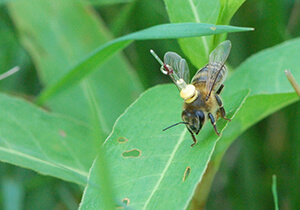
When I was in my twenties and living a fairly solitary lifestyle, I did all my food shopping at one store that was just down the street: Carrs Grocery in Anchorage, Alaska.
Now I’m older, more social, and I need to cast my shopping net wider. Marriage and two kids means I’m shopping for four people every week, so there are more visits to more stores. And beyond my family, I interact closely with the 18 people in my lab. Some people consider our lab to be the most social in the department, especially when we host BBQs at the Dyce Lab throughout the summer. The food we eat at these BBQs is typically purchased from at least a half dozen grocery stores.
What does any of this have to do with bees? Well, as most readers of this column probably know, each of the ~20,000 bee species in this world is either solitary or social. And day-to-day living as a solitary bee in a quiet nest is very different from day-to-day living as a social bee in a busy colony. Because of this, scientists have often predicted that social bees forage for food over greater distances than solitary bees, which has important consequences for things like crop pollination and exposure to environmental toxins.
But do social bees actually fly farther than solitary bees for food? What attributes of social and solitary bees influence the distance over which they forage? Does colony size matter for social bees? These are the topics for the sixty-first Notes from the Lab, where I summarize “Sociality is a key driver of foraging ranges in bees,” written by Christoph Grüter & Lucy Hayes and published in Current Biology [2022].
For their study, Grüter & Hayes took a deep dive into the literature on foraging distances by bees. There are lots of methods that researchers use to estimate foraging distance, including radar tracking (see Photo 1), mark-release-resighting studies, pollen analysis, observations on host plants, movement of natural or artificial food sources, genotyping of worker bees, and waggle dance decoding. But most researchers have used bee translocations (also called “homing”) that assess the ability of bees to re-find their nest after being released at varying distances away from their nest.
A test of the homing ability of a bee is thought to provide a good estimate of its maximum foraging range in a given environment. One advantage of using homing studies to compare foraging ranges among many bee species is that this method does not exclude certain types of bees (e.g., small bees can’t be fitted with radio transponders, so this method only works on large bees). So lots of different bee species can be compared using the same method.
In total, the authors found foraging range estimates for 90 species of bees (see Figure 1; Photos 2 & 3). Of these 90 species, 46 bee species representing six of the seven bee families were evaluated via homing ability and were therefore included in further analyses. Importantly, the authors compared foraging range estimates from homing studies with other methods, finding that all methods were highly correlated. In other words, using homing studies to compare foraging ranges among the 46 bee species was a good and robust method.
So, what did they find? Do social bees forage farther than solitary bees? Yes. Social bees of a given size have a larger foraging range than solitary bees of similar size. Larger bees also have greater foraging ranges than smaller bees, which has been known among bee researchers for a while. But the important new finding is that average-sized social bees forage up to three times farther from the colony than size-matched solitary bees.
What attributes of social bees are linked to greater foraging ranges? Colony size, communication, and consistent trips to the same patch of flowers. There is a positive relationship between colony size and foraging range among 18 species of social bees, which means bees from larger colonies have a larger foraging range. Does this mean that bees from the largest colonies in your apiary forage farther than bees from the smallest colony in your apiary? It’s probably a good guess!
Grüter & Hayes also created a mathematical model to simulate social colonies that did and didn’t communicate about high-quality food types, and individual foragers that either made consistent trips to the same patch of flowers or foraged randomly. The model revealed that communication and consistency both increased foraging distances together. This makes sense when you consider a bee communicating about a high-quality resource that happens to be far away. It may take some effort to get there, but if ….


